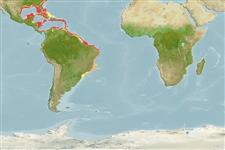Common names from other countries
Environment: milieu / climate zone / depth range / distribution range
Ecologie
marien rifbewoner; diepte 10 - 210 m (Ref. 27283). Subtropical; 35°N - 33°S, 98°W - 33°W
Western Atlantic: Bermuda, Florida (USA), western Bahamas, and Gulf of Mexico to Brazil. Also Caribbean, including Antilles (Ref. 26938).
Grootte / Gewicht / Leeftijd
Maturity: Lm ? range ? - ? cm
Max length : 28.0 cm TL mannelijk / geslacht onbekend; (Ref. 7251); common length : 17.0 cm TL mannelijk / geslacht onbekend; (Ref. 3798)
Dorsale stekels (totaal) : 13; Dorsale zachte stralen (totaal) : 13 - 14; Anale stekels: 3; Anale zachte stralen: 8. Scale rows below lateral line oblique; head entirely scaled except for front of snout near upper lip and front of chin; snout very short; the maxilla not reaching a vertical through center of eye; silvery gray with five dusky yellow stripes, the two lowermost the broadest (Ref. 13442).
Occurs along exposed outer or deeper reefs. Found on semi-hard substrates (Ref. 5217). Maximum depth down to 210 m was recorded from individuals observed by submersibles (Ref. 27283). Feeds mainly on plankton (Ref. 5217); small crustaceans (Ref. 26938).
Levenscyclus en paargedrag
Maturities | Voortplanting | Spawnings | Egg(s) | Fecundities | Larven
Oviparous, distinct pairing during breeding (Ref. 205).
Robins, C.R. and G.C. Ray, 1986. A field guide to Atlantic coast fishes of North America. Houghton Mifflin Company, Boston, U.S.A. 354 p. (Ref. 7251)
Status op de Rode Lijst van het IUCN (Ref. 130435)
CITES (Ref. 128078)
Not Evaluated
Gevaar voor de mens
Harmless
Gebruik door de mens
Visserij: van minder commercieel belang; Aquarium: Publieke aquaria
Tools
Speciale rapporten
Download XML
Internetbronnen
Estimates based on models
Preferred temperature (Ref.
115969): 21.4 - 27.8, mean 25.5 (based on 392 cells).
Fylogenetische diversiteitsindex (Ref.
82804): PD
50 = 0.5000 [Uniqueness, from 0.5 = low to 2.0 = high].
Bayesian length-weight: a=0.00389 (0.00180 - 0.00842), b=3.12 (2.94 - 3.30), in cm Total Length, based on all LWR estimates for this body shape (Ref.
93245).
Trofisch niveau (Ref.
69278): 3.4 ±0.45 se; based on food items.
Weerstandsvermogen (Ref.
120179): Gemiddeld, minimale populatieverdubbelingstijd 1,4-4,4 jaar (Preliminary K or Fecundity.).
Fishing Vulnerability (Ref.
59153): Low vulnerability (18 of 100).
